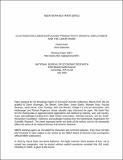Is Automation Labor Share-Displacing? Productivity Growth, Employment, and the Labor Share
Author(s)
Autor, David H; Salomons, Anna
DownloadAccepted version (1.118Mb)
Terms of use
Metadata
Show full item recordAbstract
Many technological innovations replace workers with machines. But this capital–labor substitution need not reduce aggregate labor demand, because it simultaneously induces four countervail-ing responses: own-industry output effects; cross-industry input–output effects; between-industry shifts; and final demand effects. We quantify these channels using four decades of harmonized cross-country and industry data, whereby we measure automation as industry-level movements in total factor productivity that are common across countries. We find that automation displaces employment and reduces labor’s share of value added in the industries where it originates (a direct effect). In the case of employment, these own-industry losses are reversed by indirect gains in customer industries and induced increases in aggregate demand. By contrast, own-industry labor share losses are not recouped elsewhere. Our framework can account for a substantial fraction of the reallocation of employment across industries and the aggregate fall in the labor share over the last three decades. It does not, however, explain why the labor share fell more rapidly during the 2000s.
Date issued
2018Department
Massachusetts Institute of Technology. Department of EconomicsJournal
Brookings Papers on Economic Activity
Publisher
Brookings Institution Press
Citation
Autor, David, and Anna Salomons. "Is Automation Labor Share-Displacing? Productivity Growth, Employment, and the Labor Share." Brookings Papers on Economic Activity, Spring 2018, p. 1-87.
Version: Author's final manuscript
ISSN
1533-4465
0007-2303